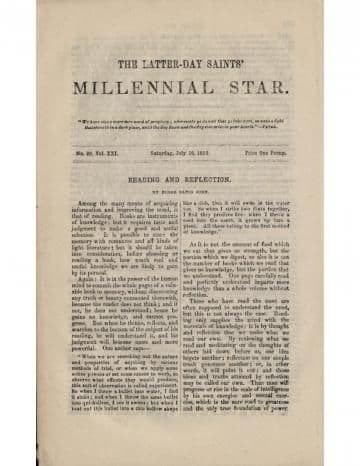Magazine
American Antiquities: Corroborative of the Book of Mormon (16 July 1859)

Title
American Antiquities: Corroborative of the Book of Mormon (16 July 1859)
Magazine
The Latter Day Saints' Millennial Star
Publication Type
Magazine Article
Year of Publication
1859
Editors
Calkin, Asa (Secondary)
Number of Pages
467
Date Published
16 July 1859
Volume
21
Issue Number
29
Abstract
This 47-part series provides evidence to confirm the authenticity of the Book of Mormon. It describes the contents of the Book of Mormon and archaeological findings and discoveries, such as ancient cities, temples, altars, tools, and wells. Each part contains several excerpts from other publications that support the Book of Mormon.
AMERICAN ANTIQUITIES,
CORROBORATIVE OF THE BOOK OF MORMON.
(Continued from page 451.)
From Rally's "Journal of a Tour in unsettled parts of North America. in 1796 and 1797,” published in London in 1856.)
“In the morning I went out to see the curious remains of antiquity with which this place [Grave Creek] abounds. They consist of circular and square entrenchments and mounds, which are scattered at different distances for ten or twelve miles along the banks of the Ohio. One of the principal circular entrenchments is on the very spot where the settlement is built; and three of the principal mounds also are within a hundred yards of the same, one of which is near one hundred feet high, and has trees growing on it to the very top, some of which must be very old: at least, they appear of the same size and age with those which grow in the surrounding valley. With respect to the entrenchments, they are about breast high, and appear, from their situation, &c., to have been intended for and used as fortifications; and these mounds (from which the settlement takes its name,) seem to have been graves, either used as public burying-places or thrown up for those dead who might have fallen in some engagement near the place. I was informed that one of these mounds has been opened, and that it was found to contain human bones, which (if true,) confirms the opinion." “I have seen several of these ancient remains in different parts of the country near the Ohio. On the two Miami rivers they are very numerous; and I have not the least doubt in my own mind but that they were built by a race of people more enlightened than the present Indiana, and at some period of time very far distant; for the present Indians know nothing about their use, nor have they any tradition concerning them."
(From the “Quarterly Review,” October, 1839.)
“The eye of the antiquarian cannot fail to be both attracted and fixed by the evidences of the existence of two great branches of the hieroglyphical language, both, having striking affinities with the Egyptian, and yet distinguished from it by characteristics perfectly American. One is the picture-writing peculiar to the Mexicans, and which displays several striking traits of assimilation to the anaglyphs and the historical tablets of the Egyptian temples. The second is a pure hieroglyphical language, to which little attention has been hitherto called, which appears to have been peculiar to the Tultecan or some still more ancient nation that preceded the Mexican, which was as complete as the Egyptian in its double consistency of a symbolic and a phonetic alphabet, and which, as far as we can judge, appears to have rivalled the Egyptian in its completeness, while in some respects it excelled it in its regularity and beauty.”
(From the “Millennial Star" Feb. 14, 1857.)
“The ruins of an extensive city have recently been discovered in California, and of another in Texas, where the stone walls of a splendid edifice are yet standing. Also in the Rocky Mountains, in Utah, the ruins of several cities have been discovered, with the walls of some buildings yet standing as high as three or four stories, with almost endless numbers of inscriptions engraved on smooth surfaces of stone.”
(From the Saturday Magazine, Nov 1, 1834.)
“Artificial mounds of earth in the form of pyramids are of frequent occurrence in many parts of Mexico. They were constructed by the inhabitants of those countries before the Spanish conquest, and were used for the purposes of worship and as burial-places for the kings and chief priests. The pyramid of Cholula is considered the largest of these singular structures.”
(To be continued.)
Subject Keywords
Bibliographic Citation
Terms of use
Items in the BMC Archive are made publicly available for non-commercial, private use. Inclusion within the BMC Archive does not imply endorsement. Items do not represent the official views of The Church of Jesus Christ of Latter-day Saints or of Book of Mormon Central.